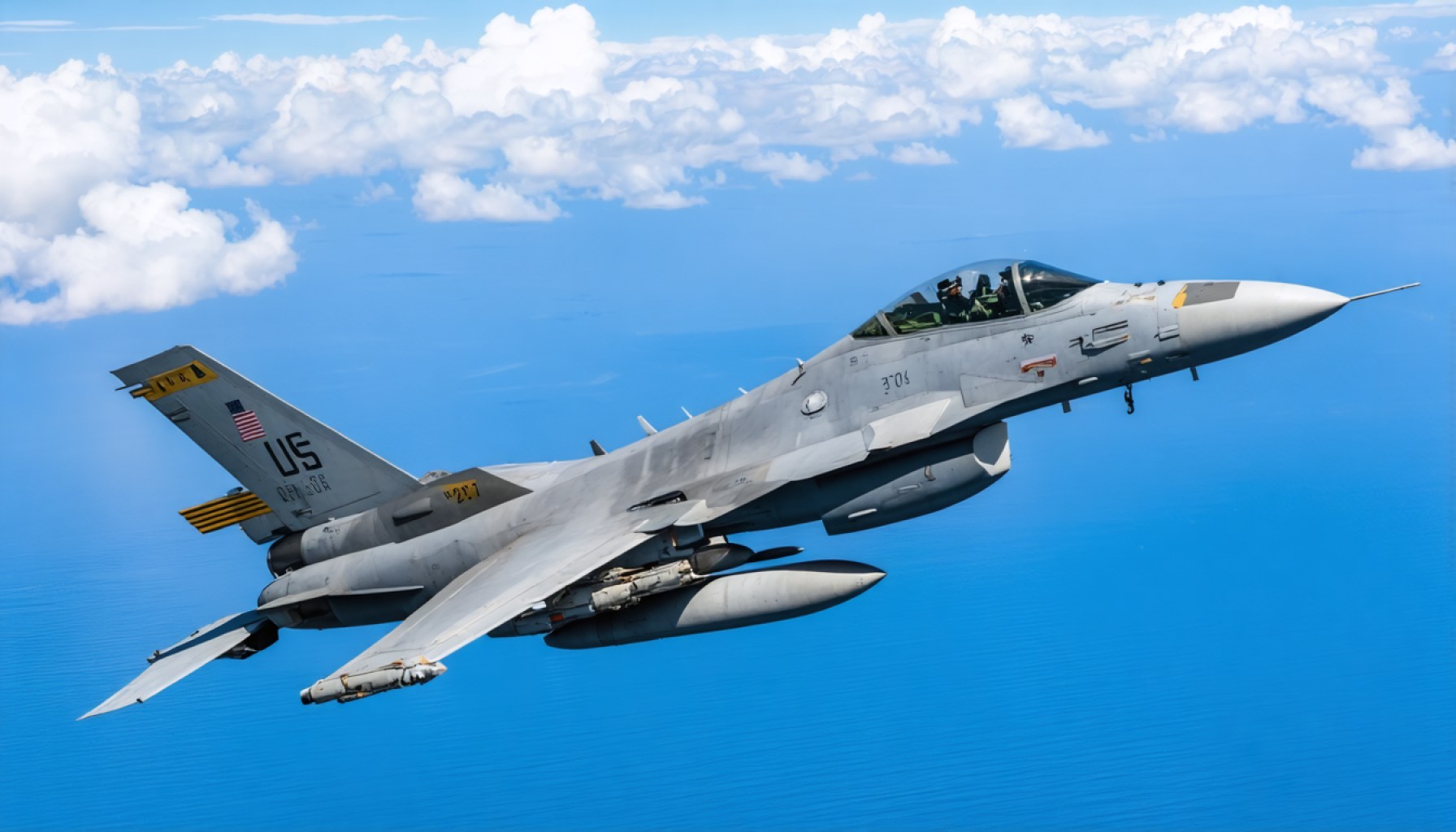
The Philippines is set to enhance its defense capabilities with the acquisition of 20 U.S.-made F-16 fighter jets, valued at $5.
58 billion.This acquisition aligns with U.S.

strategic realignment towards Asia, addressing growing tensions with China in the South China Sea and around Taiwan.Equipped with advanced technology, these F-16 jets will bolster the Philippine Air Force’s ability to monitor and defend its maritime domain.The partnership emphasizes a reinforced alliance between the U.
S. and the Philippines, positioning the latter as a key player in regional stability.The U.
S. aims to reassure its commitment to allies in Asia as part of a broader global strategic shift from Europe to Asia.This defense deal symbolizes a commitment to safeguarding shared principles and fostering diplomatic dialogue in a rapidly evolving geopolitical landscape.
Watch this video on YouTube.Against the vibrant backdrop of Philippine skies, an emblem of power takes flight—the formidable US-manufactured F-16 fighter jet. This sleek avian marvel is poised to redefine the Philippines’ defensive capabilities amid growing geopolitical turbulence in Southeast Asia.
Draped in tactical markings, these jets symbolize an era where alliances are forged stronger than the very steel that shapes these ace warbirds.In a decisive move, the United States has sanctioned an extensive $5.58 billion deal to supply F-16 jets to the Philippines.
This deal, a linchpin in the elaborate choreography of global strategy, aligns with Washington’s pivot towards Asia amidst intensifying unease over China’s assertive posturing. With tensions simmering in the South China Sea and shadows of disputes looming over Taiwan, these aircraft are not mere machines but sentinels of sovereignty.Manufactured with precision and purpose, the 20 F-16 fighter jets come equipped with cutting-edge technology designed to reinforce the Philippine Air Force.
Not merely defense spectacles, these jets hold the promise of magnifying maritime domain awareness and amplifying the nation’s capability to quell threats against its skies.U.S.
officials reaffirm their commitment to the Philippines, painting it as a bastion of stability and political equilibrium in a region marked by shifting alliances and unpredictable tides. Defense narratives flicker like beacons in the night, declaring the strategic essence of this move—to secure a transformative presence that transcends mere air capabilities.In the broader theater of global politics, America’s shift is emblematic of a broader strategic realignment.
While Europe’s shores witness a recalibration of military focuses amid fluctuating Russian narratives, Asia emerges as the new frontline. The message resonates clear: communities are defined by their defense, where the steadfast wings of an F-16 stand guard not just over territories but over principles.Engaging the Filipinos, U.
S. Secretary of State Marco Rubio extends a firm handshake of reassurance—in stark contrast to past narratives of allied burden-sharing. It’s a symbiotic dance of commitment where defense technologies become the vocabulary in dialogues of diplomacy.
On the sunlit runways of Basa Air Base, where Philippine and U.S. personnel stand shoulder to shoulder, a new chapter unfurls.
This isn’t just about jets; it’s about safeguarding the ideals that these aircraft will protect as they carve narratives in the azure vault above. As the engines roar to life, they carry with them a multitude of aspirations—of peace amidst the storm, of preparedness against challenge, and above all, of a future where deterrence stems from demonstrated unity.Why the F-16 Fighter Jets are a Game Changer for the PhilippinesIntroductionThe strategic allocation of 20 US-manufactured F-16 fighter jets to the Philippines marks a transformative chapter in regional defense and geopolitical dynamics.
This article delves deeper into the implications of this significant deal, analyzing how these advanced aircraft are poised to bolster the nation’s airborne capabilities amidst escalating tensions in Southeast Asia.Understanding the F-16’s Advanced Features and CapabilitiesThe F-16 jets, famous for their versatility, are a sterling addition to the Philippine Air Force. Crafted with advanced aerodynamics and equipped with state-of-the-art avionics, these jets:– Enhanced Radar Systems: Incorporate AN/APG-83 AESA radar, allowing improved target detection and tracking capabilities both in the air and at sea.
– Advanced Weaponry: Can be equipped with a wide range of weapons, including air-to-air and air-to-ground missiles, enhancing combat readiness.– Superior Maneuverability: Renowned for exceptional speed and agility, making them formidable in dogfights and versatile in various combat scenarios.Strategic Implications in Southeast AsiaThe deployment of these jets signifies not only military strengthening but also a subtle but profound geopolitical messaging:– Deterrence Against Aggression: In light of assertive territorial claims in the South China Sea, these jets serve as a deterrence against potential conflicts and territorial breaches.
– Strengthening Alliances: Reinforces the U.S.-Philippines defense ties, aligning with broader U.
S. strategy to counterbalance China’s influence in the region.Real-World Use Cases and Operational ReadinessThese jets aren’t just symbols of defense; they bring tangible enhancements to operational readiness:– Maritime Surveillance: They will significantly improve maritime surveillance capabilities, crucial for monitoring disputed areas and protecting sovereign waters.
– Training and Modernization: The acquisition includes training for Filipino pilots and maintenance crews, ensuring long-term operational sustainability and modernization of the current air fleet.Market Forecast and Industry Trends– Global Defense Spending: Reflective of a global trend where countries are increasingly prioritizing aerial defense due to burgeoning global threats.– Technological Advancements: Continuous upgrades to jets like the F-16 indicate the aviation industry’s shift toward integrating AI and machine learning for defense efficiency.
Potential Limitations and ControversiesWhile advantageous, the F-16 deal raises certain limitations and debates:– Economic Concerns: The substantial financial investment might raise fiscal concerns given other pressing domestic priorities.– Regional Tensions: This move might escalate tensions with neighboring countries due to perceived threats, necessitating cautious diplomatic engagements.Insights & Recommendations– Balanced Approach: The Philippines should continue building complementary defense capabilities such as radar systems and coastal defenses to support air capabilities comprehensively.
– Diplomatic Engagement: Ongoing diplomatic negotiations should ensue to ensure regional stability and reduce the risk of militarized conflicts.Quick Tips for Immediate Action– Pilot Training: Initiate intensive training programs to ensure that pilots are mission-ready once the jets are fully operational.– Community Engagement: Publicize the defensive nature of this acquisition to foster better understanding and support among the Filipino populace.
ConclusionThe acquisition of F-16 fighter jets represents more than just an enhancement of military capabilities for the Philippines; it reflects a broader strategic alignment and a strengthened partnership with the United States. As the geopolitical landscape evolves, these jets stand as a testament to preparedness and deterrence, shielding not just territorial integrity but also core democratic principles. For more information on global defense strategies and trends, visit the Lockheed Martin website.
Artykuł Skyward Defense: US Equips Philippines with Tactical F-16 Warplanes Amid Escalating Tensions pochodzi z serwisu BeBlog..











